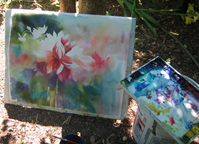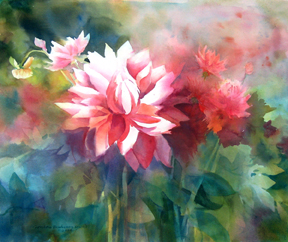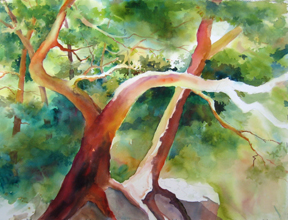Ruby My Dear in the garden
 Often students ask to have a workshop on finishing paintings. The trouble with this is the way you finish one painting is not the way you finish the next. I can give you some guidelines but when each painting is done is as individual as the painting itself and its creator.
Often students ask to have a workshop on finishing paintings. The trouble with this is the way you finish one painting is not the way you finish the next. I can give you some guidelines but when each painting is done is as individual as the painting itself and its creator.
Years ago I was dating a man who had no grasp of what it was to be making art. I gave him the book, “The Zen of Seeing,” and said, “If you are going to understand art, you are going to have to get in touch with your feelings.” Not one to blush he said, “I reject that.”
He went on to say, “It can’t be all about feelings. There has to be some structure.For example, give me a definition of a good composition.” I sputtered a bit, thinking of Baroque compositions compared to Renaissance, but then came up with a definition I will stand by still today. I said,
- A good composition is so right, that if you changed one single thing it would be less right.”
“But that is a subjective decision.”
“Right,” said I. “I rest my case.”

Ruby My Dear
When is a painting finished? When it comes into balance. When everything thing is there for a purpose and working together. And there is not one thing (stroke, object, color) that is not contributing to the whole.
Rex Brandt used to say, “The only SINGLE thing is the painting. Everything else is in relation to the other things in the painting.”
“Fine,” you say, “But how do I know?”

Slow down. I see people working to finish their paintings as though they will get to go out to play as soon as they are done. The closer I get to being finished, more time is spent looking and less in painting.
Get away from it and look with fresh eyes. Get up or walk away. Set the painting up where you can see it when you return.
Articulate the question to yourself and walk away. When you return be open-minded about possible answers.
Walk through your painting — saying, “That’s okay. That’s okay. That’s okay.” When you get to an blockage, a not-okay say, “There is a problem here.”
Okay — now you know what you are going to do: paint that back shape darker; dull the bright orange on the outer edge, etc. Do that AND NO MORE!
As soon as you have done the one or two things you decided, put the painting up and look at it again. Walk away and look at it when you come back. Too often, people do the two things they saw and then just keep going — only to discover that all of those additional work did not make it better.

Practice what I call, “loose eyeballs.” Just let your eyes rove over the painting without THINKING so much. When they get stuck, then ask yourself why.
Where I pin up my paintings in my studio (see January, 2009), I can see them as I talk on the phone or pay bills. All of a sudden I will have an answer to that question I’d asked.
When you put your painting up and say, “That’s okay… that’s okay…. that’ sokay…” and you keep going until you are back where you started without a stumble -the painting is done!

Cliff Madronas
However, if the painting was better an hour ago, if it looks overworked, if some of your decisions are not making the painting better but just trying for a “save,” and if you find yourself thinking, “I could have done it better,” it is time to draw it up again and treat this painting as a draft (see last month’s column). Hard to do, but you will be glad you did.
What kinds of things should you be considering toward the end of the painting?
- Hang onto more lights, more white paper than you need until the very end. Then gradually knock back the ones that are not leading you through the painting. (Notice the diminishing whites in Cliff Madronas, but we still feel the sunshine).
- Do you end up at your focal area? Should you punch it up a bit?
- lightest light against darkest dark (darks pushing out the lights)
- a color or shape found nowhere else
- a brighter version of a color used other places
- the strongest diagonal should be leading toward it
- hard edges beat soft
- strong contrasts of color or of value beat close contrasts
- Check your bright and dulls of each different hue. A warm bright too far away from the focus may pull the eye away.
- Would a unifying glaze settle down a busy background or out-of-focus area? This is when I choose viridian, cobalt blue, quinacridone rose, or sometimes quinacridone gold and float on a unifying glaze (see Stretching your Paper, June, 2009).
A final check list:
- Does the painting come into balance, all parts working toward the whole?
- Does it reflect what I was trying to “say”?
- Does it please me?
- Is the walk through the painting interesting, going where I want it to, and ultimately satisfying?
If so, your painting is finished. Sign it. Photograph it. Frame it. Enjoy it!
© 2009, Caroline Buchanan
